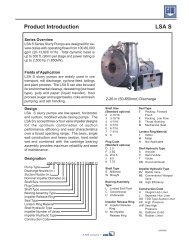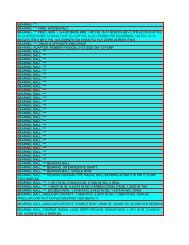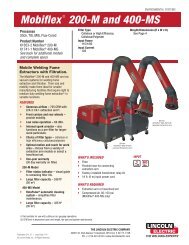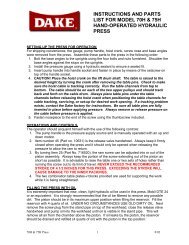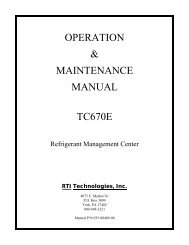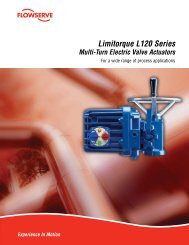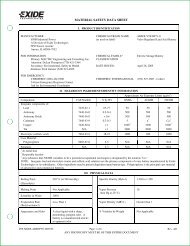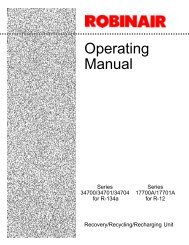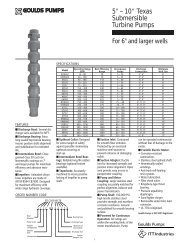Attachment 2 - American Electric Power
Attachment 2 - American Electric Power
Attachment 2 - American Electric Power
You also want an ePaper? Increase the reach of your titles
YUMPU automatically turns print PDFs into web optimized ePapers that Google loves.
OUTDOORSPLIT-SYSTEM COOLINGINSTALLATION INSTRUCTION Supersedes: 550.46-N1Y(197 & 198) 550.46-N1Y(598)1 Ø H*RA, H*RC and H*RE(10, 12 and 14 SEER) MODELSNOMENCLATURE035-13606Product CategoryH = Air Conditioning, Outdoor UnitH 1 RA 018 S 06Product Generation1,2 = Design LevelProduct IdentifierRA = 10 SEER Split-System Air ConditioningRC = 12 SEER Split-System Air ConditioningRE = 14 SEER Split-System Air ConditioningGENERALThese outdoor units are designed to be connected to a matchingUPG indoor coil with sweat connection lines. These unitsare factory charged with refrigerant for a matching indoor coilplus 15 feet of field supplied line. The outside unit is designedto be placed alongside or at the back of the home, remote fromthe indoor coil. The outdoor unit has been factory run-testedand all components of the system are ready for easy, immediateinstallation.INSPECTIONCheck the unit thoroughly for shipping damage. Unusuallyrough handling during shipment may loosen blowers, fan motors,compressors, or other components. Be sure that the unitis ready to operate before installing it. If there is damage, file aclaim with the shipper. See Form 50.15-NM for more information.REFERENCEUse this instruction in conjunction with the instructions for theappropriate indoor unit, air moving system and accessories.Installer should pay particular attention to the words NOTE,CAUTION and WARNING.NOTES are intended to clarify or make the installation easier.CAUTIONS identify procedures which, if not followed carefully,could result in personal injury, property damage or productdamage.WARNINGS are given to alert the installer that severe personalinjury, death or equipment damage may result if installationprocedures are not followed properly.Nominal Cooling Capacity018=18,000 BTUH024=24,000 BTUH030=30,000 BTUH036=36,000 BTUHRefrigerant Line ConnectionsS = Sweat-ConnectVoltage Code06 = 208/230-1-60LIMITATIONSCaution:042=42,000 BTUH048=48,000 BTUH060=60,000 BTUHThe manufacturer is not responsible for the performanceof a mismatched system. The outdoorunit must be installed with a compatible indoor unitas designated in the specification data or in theDirectory of Certified Unitary Air Conditioners publishedby the Air Conditioning and RefrigerationInstitute. Using unmatched components may notonly affect the performance of the system, but mayalso void the warranty of the equipment.Do not install any coil in a furnace which is to beoperated during the heating season without attachingthe refrigerant lines to the coil. Allowing the coilcharge to enter the refrigerant lines prevents excessiverefrigerant pressure build-up and possiblecoil damage.The unit should be installed in accordance with all national andlocal codes and regulations which govern the installation of thistype of equipment. In lieu of local codes, the equipment shouldbe installed in accordance with the National <strong>Electric</strong> Code, andin accordance with the recommendations made by the NationalBoard of Fire Underwriters.Limitations for the indoor unit, coil and appropriate accessoriesmust also be observed.The outdoor unit must not be installed with any duct work in theair stream. The outdoor fan is the propeller type and is notdesigned to operate against any additional external static pressure.The maximum and minimum conditions for operation must beobserved to assure a system that provides maximum performancewith minimum service.
550.46-N1YTABLE 1 - APPLICATION LIMITATIONSAMBIENT AIR TEMPERATUREON OUTDOOR COILAIR TEMPERATUREON INDOOR COILMin. °DB Max. °DB Min. °WB Max. °WB50 120 57 72CHECK ELECTRICAL POWER SUPPLYThe electrical power should be checked to determine if adequatepower is available, and near constant voltage can bemaintained. If there is any question concerning the powersupply, contact the local power company for corrections; otherwise,unsatisfactory performance may result.SELECTING EQUIPMENT LOCATIONSSeveral important factors must be considered before selectingthe best site for the air conditioning outside unit:• Distance to indoor coil• Proximity to the structure• Proximity to vents and exhaust systems• Ability to service• Sound transmission• Air circulation• Wind direction• Relationship between structure, sun, and unit• Distance from power source• Water drainage• Local codesLocate the outside unit near enough to the indoor coil vicinityto eliminate lengthy refrigerant line runs. Do not locate theoutside unit so it discharges air under eaves or gutters. Rain orsnow melt-off should not be able to run off a roof and downupon the unit. Be sure vents are not located upwind from theoutside unit.The length of the refrigerant tubing, between the outdoor unitand indoor coil, should be as short as possible to avoid capacityand efficiency loss. Excessive spacing of the outside unit fromthe home can lead to the refrigerant lines being restricted bytrampling or by being punctured by lawn mowers. Locate theoutside unit away from bedroom windows or other rooms wheresound might be objectionable.Adverse effects of prevailing winds, blowing snow or sleet onthe outdoor coil can be eliminated by placing the outside unitwhere the wind does not blow across the unit. Trees, shrubs,corners of buildings and fences standing off from the coil canreduce capacity loss due to wind chill effect.Provide ample clearance from shrubs to allow adequate air topass across the outdoor coil without leaves or branches beingpulled into the coil.Consideration should be given to the distance and routing ofelectrical service that would have to be run to connect theoutside unit.The unit must be located outdoors and must not be connectedto duct work. It is recommended the outside unit be mountedon a concrete pad. Top of pad should be two inches abovegrade.OUTDOOR UNITAfter the site has been selected a concrete base pad shouldbe provided. The concrete pad should not come in contact withthe foundation or side of the structure because sound may betransmitted to the residence. The concrete pad need not be anylarger than the outside dimensions of the outdoor unit. Theconcrete pad should be located far enough away from thestructure so the outside unit is not closer than its minimumdistances. See Figure 1. Set the outside unit upon the pad withcare to avoid damage.A minimum clearance of 18 inches is required on one side ofthe control panel for service. A 10 inch clearance is required forthe air inlet to the outdoor coil around the perimeter of the unit.The air discharge of the unit requires a 60 inch clearancebetween the top of the unit and any obstruction. See Figure 1.Caution:Do not remove the protective caps or plugs fromthe unit refrigerant connections until the refrigerantlines are run and ready for final connection. If thisprocedure is not observed, dirt and other particleswill get into the system and plug various orificesand small tubes.60" OVERHEADCLEARANCE18" SERVICEACCESS CLEARANCEWEATHERPROOFDISCONNECTSWITCHTHERMOSTATTO FURNACE OR AIR HANDLERTERMINAL BLOCKNEC CLASS 1 WIRINGNEC CLASS 2 WIRING10" CLEARANCECOIL AREATO INDOOR COILNOTE: ALL OUTDOOR WIRING MUSTBE WEATHERPROOFSEAL OPENING(S) WITH PERMAGUM OR EQUIVALENTFIGURE 1 - OUTDOOR UNIT LOCATIONCONTROL ACCESS PANEL2 Unitary Products Group
550.46-N1Yelevation differences, and/or long total line lengths. An additionalorifice(s) is shipped with most outdoor units for the mostcommonly required replacement combinations. Other sizesmust be ordered from the Source 1 Parts Department if required.FIGURE 2 - Vapor Line InsulatingCHARGING AND LEAK TESTINGOn systems with or without service valves the refrigerantshould be recovered or recycled in accordance with EPA regulations.In some cases this may require putting piercing valveson both the high and low sides of the system.WARNING: DO NOT vent refrigerant to the outdoors.When recovering refrigerant from a system, with a burnout,follow a safe procedure due to possible contamination.CAUTION: Avoid getting the refrigerant in the eyes or on theskin.Contaminated refrigerant must be recovered andreturned to the local refrigeration supply house forproper disposition.TOTAL LINE LENGTHUnits should be installed only with approved system combination(indoor/outdoor) as specified in the Technical Guide.For systems with total line length exceeding 50 feet, seeAPPLICATION DATA, 690.01-AD1V(1291) and worksheet690.01-AD1.1V(791) "General Piping Recommendations andRefrigerant Line Length" for vapor and liquid line sizing, calibrationof liquid line pressure loss or gain, determination ofvapor line velocity, elevation limitations, orifice connections,system charging, traps, etc.Systems with liquid line pressure loss or gain greater than 11psi must be provided with corrected orifice size as noted inForm 690.01 - AD1V (1291).ORIFICE SELECTION (ORIFICE TYPE COILSONLY)NOTE: The proper orifice must be installed in the evaporatorcoil liquid line connection prior to the connection of therefrigerant lines.WARNING: Coil is under 35 psig (inert gas) pressure,Each coil has an orifice installed in the fitting between the liquidline connection and distributor. The orifice is identified on alabel next to the liquid line connection.The orifice shipped with the indoor coil is based on the “mostsold” combination. The indoor coil orifice may be changed,depending on the capacity and efficiency of the outdoor unit,See the appropriate Data Sheet for the correct orifice size. Ifthe orifice size matches, nothing further is required and therefrigerant lines may be connected per the outdoor unit instruction.However, if another orifice should be used, see the coilinstruction for details to change to change the orifice in the coil.OPENING BASE VALVESAll models in this series have brass service valves. Thesevalves are not back seating. Opening or closing valve does notclose service port. Service ports have Schrader valves forgauge connections. Use back-up wrench on valve body whenremoving cap to open or close the valve. To open, insert hexwrench into stem and back out counter clockwise until stem justtouches retaining ring.CAUTION: If the valve stem is backed out beyond the retainingring, system pressure could force the stem out ofthe valve body and possibly cause personal injury.In the event that the retaining ring is missing do notattempt to open the valve.All caps must be replaced to prevent leaks.Replace valve cap finger tight, then tighten an additional 1 ⁄ 6 ofa turn with a wrench, using a back-up wrench on the valve body.OIL TRAPPINGWhen the outdoor unit is above the indoor coil oil trapping isnecessary. Please refer to APPLICATION DATA, 690.01-AD1V(1291) and worksheet 690.01-AD1.1V (791) "General PipingRecommendations and Refrigerant Line Length".Check the system for correct charge after all components ofthe system have been installed, connected and wired correctly.Connect service gauges to the suction and discharge serviceports.Allow unit to operate until system pressures and temperatureshave stabilized, making sure that the pressure and temperaturesalign with unit service data. If not, check system chargeand adjust if necessary.ELECTRICAL WIRINGWARNING:To prevent electrical shock, open remote disconnectso electrical supply to outdoor unit is shut offcontactor does not open both sides of the 230 voltelectrical circuit.POWER SUPPLYAll wiring must comply with N.E.C. and local codes. See ratingplate and product data sheet for volts, frequency, phase, maximumfuse size and minimum branch circuit ampacity. Refer tothe wiring diagram inside the unit control box cover beforeconnecting to power supply.1. The line voltage service wiring for the outdoor unit mustinclude a disconnect switch located with and in sight of theoutdoor unit.4 Unitary Products Group
550.46-N1Y L1L2 FIGURE 3 - TYPICAL CONDENSING UNIT CONTROL BOX(Start Components Shown) L1L2 FIGURE 4 - TYPICAL CONDENSING UNIT CONTROL BOX(Start Components Shown)2. Use the correct size fuse or circuit breaker as listed on theunit rating plate and data sheet. See data sheet for minimumrecommended wire size. If using nonmetallicsheathedcable (NM or NM-B) ampacities shall be that of60°C conductors per NEC 336-26.3. Wiring connections.Two are provided in the control box:a. One for low voltage wiring.b. One entrance for high voltage Ll and L2The reversible High Voltage Conduit Plate is factoryinstalled for 1/2" conduit connections. For 3/4" conduit,remove the screw holding the plate in place and reversethe location of the holes. For 1" conduit, remove theconduit plate and discard. Re - install screw to maintainthe integrity of the unit structure, regardless of theconduit being used. See Figures 3 and 4.4. <strong>Power</strong> connection to the unit is facilitated by screw terminals,marked Ll and L2 on the outdoor unit contactor. SeeFigures 3 and 4.5. Ground the outdoor unit using the ground lug provided.Unless the outdoor unit is grounded through proper wiringto the service entrance ground, a suitable separate groundshould be provided at the outdoor unit.Unitary Products Group 5
550.46-N1Y FIGURE 5 - TYPICAL FIELD WIRINGCAUTION: Casing or cabinet must be permanently groundedin accordance with National <strong>Electric</strong> Code or otherapplicable local codes.LOW VOLTAGEControl wiring may vary, depending upon the type of thermostat,furnace or air handler being connected.Low voltage wiring diagrams can be found with the furnace orair conditioning blower package installation instructions.Pig-tail connector wires (two blue or one blue, one brown) areprovided from the low voltage pull-in coil on the contactor to asection of the control box. A “fingered” bushing is provided inthe low voltage knockout hole. If 1 ⁄ 2 " conduit is used for the lowvoltage wiring, the bushing is to be removed.1. Route the low voltage cable through the fingered bushingin the low voltage junction box. See Figure 3 and 4.2. Using wire nuts, connect low voltage wiring as shown inFigure 5.3. A minimum 19 AWG wire gauge for total lengths notexceding 130 feet must be used in connecting the lowvoltage control wiring between the outdoor unit, furnaceand thermostat. For longer low voltage control wiringlengths, consult the N.E.C.Connect thermostat and control package wiring as shownin Figure 5 and per the instructions packed with thosepieces.SYSTEM CHARGEThe factory charge in the outdoor unit includes enough chargefor the unit and a most sold matched evaporator. Some indoorcoil matches may require some additional charge. See TabularData sheet provided in unit literature packet.Sweat connect units also include sufficient charge for 15 feetof lines. Pre-charged line lengths are factory charged with thecorrect amount of refrigerant required. Table 2 lists the refrigerantline charges.The “TOTAL SYSTEM CHARGE” must be permanentlystamped on the unit data plate.Total system charge is determined as follows:1. Determine outdoor unit charge from tabular data sheet.2. Determine indoor coil adjustment from tabular data sheet.3. Calculate the line charge using Table 2 factors. Calculateover 15 feet of sweat lines for sweat connect units.NOTE: For sweat connect lines, the line charge over 15 feetshould be included on the data plate and must beadded to the system.4. Total system charge = item 1 + item 2 + item 3.5. Permanently stamp the unit data plate with the totalamount of refrigerant in the system.Use one of the following charging methods whenever additionalrefrigerant is required for the system charge.CAUTION: Refrigerant charging should only be carried out bya qualified air conditioning contractor.Measurement MethodIf a calibrated charging cylinder or accurate weighing device isavailable, add refrigerant accordingly.CAUTION: Compressor damage will occur if system is improperlycharged. On new system installations chargesystem per R-22 charge information label and followguidelines in this instruction.Check flare caps on service ports to be sure they are leak tight.DO NOT OVER TIGHTEN (between 40 and 60 inch - lbs.maximum).Superheat Charging MethodNOTE: Use this method only during system maintenace andrepair.1. Operate system until temperatures and pressures stabilize(minimum of 10 minutes).2. Measure and record indoor wet bulb (WB) temperatureusing a sling psychrometer and the outdoor dry bulb (DB)temperature using a thermometer.6 Unitary Products Group
550.46-N1YTABLE 3 - Superheat ValueINDOOROUTDOOR DB°FWB °F*55 60 65 70 75 80 85 90 95 100 105 110 11550 9 752 12 10 654 14 12 10 756 17 15 14 10 658 20 18 16 13 9 560 23 21 19 16 12 8 662 26 24 22 19 16 12 8 564 29 27 24 21 18 15 11 9 666 32 31 30 24 23 18 15 11 9 668 35 33 30 27 24 21 19 16 14 12 9 670 35 33 30 28 25 22 20 18 15 13 11 872 35 33 30 28 26 24 20 20 17 15 1474 34 31 30 27 25 23 22 20 1876 35 33 31 29 27 26 25 23*Evaporator Entering Air °FTABLE 4 - Temperature and PressureSUCTIONPRESSUREPSIG(Service Port)SUCTION SERVICE VALVE SUPERHEAT0** 2 4 6 8 10 12 14 16 18 20 22 24 26 28 30 32 3461.5 35 37 39 41 43 45 47 49 51 53 55 57 59 61 63 65 67 6964.2 37 39 41 43 45 47 49 51 53 55 57 59 61 63 65 67 69 7167.1 39 41 43 45 47 49 51 53 55 57 59 61 63 65 67 69 71 7370.0 41 43 45 47 49 51 53 55 57 59 61 63 65 67 69 71 73 7573.0 43 45 47 49 51 53 55 57 59 61 63 63 67 69 71 73 75 7776.0 45 47 49 51 53 55 57 59 61 63 65 67 69 71 73 75 77 7979.2 47 49 51 53 55 57 59 61 63 65 67 69 71 73 75 77 79 8182.4 49 51 53 55 57 59 61 63 65 67 69 71 73 75 77 79 81 83** Saturation TemperatureTABLE 5 - R-22 Saturation PropertiesTEMP.°FPRESSUREPSIGTEMP.°FPRESSUREPSIGTEMP.°FPRESSUREPSIGTEMP.°FPRESSUREPSIGTEMP.°FPRESSUREPSIG45 76.02 60 101.62 75 132.22 90 168.40 105 210.7546 77.58 61 103.49 76 134.45 91 171.02 106 213.8147 79.17 62 105.39 77 136.71 92 173.67 107 216.9048 80.77 63 107.32 78 138.99 93 176.35 108 220.0249 82.39 64 109.26 79 141.30 94 179.06 109 223.1750 84.03 65 111.23 80 143.63 95 181.80 110 226.3551 85.69 66 113.22 81 145.99 96 184,56 111 229.5652 87.38 67 115.24 82 148.37 97 187.36 112 232.8053 89.08 68 117.28 83 150.78 98 190.18 113 236.0854 90.81 69 119.34 84 153.22 99 193.03 114 239.3855 92.56 70 121.43 85 155.68 100 195.91 115 242.7256 94.32 71 123.54 86 158.17 101 198.82 116 246.1057 96.11 72 125.67 87 160.69 102 201.76 117 249.5058 97.93 73 127.83 88 163.23 103 204.72 118 252.9459 99.76 74 130.01 89 165.80 104 207.72 119 256.41Unitary Products Group 7
3. Measure and record the suction pressure at the suctionservice valve port.4. Using Table 4, note the superheat value corresponding tothe intersection of the indoor wet bulb and the outdoor drybulb.5. With the superheat value obtained in step 4 and thesuction pressure value from step 3, find the intersection ofthe values in Table 5. This is the required suction tubetemperature at the suction service valve.6. To bring the tube temperature in line with the requiredvalue from Table 5, add refrigerant to the service port tocause the tube temperature to fall and reclaim refrigerantto cause the temperature to rise.CHECKOUT PROCEDUREUse the following list to see that nothing was over looked.Have all braze joints on refrigerant lines been leakedchecked?Have base valves been opened?Have all refrigerant lines been secured and isolatedproperly?Is the indoor coil drain hooked up and draining freely? Pourwater in drain pan.Is air filter installed and clean?Is blower motor speed set correctly?SYSTEM OPERATION CHECK-OUTSTEP 1 - With thermostat set to the OFF position, closedisconnect switch or switches to complete circuits to condensingunit, furnace or air handler. Set thermostat to call for cooling.STEP 2 - After the system starts, check the voltage andamperage at the condensing unit contactor.STEP 3 - If voltage is not within 10% of rated voltage, oramperage greatly exceeds nameplate amperage, shut downthe system and contact the local power company for corrections;otherwise unsatisfactory performance may result.STEP 4 - With the system in operation, check the condensingunit for unusual noises and undue vibration.STEP 5 - Allow the system to operate until it is balancd orstabilized (approximately 30 minutes), before making furtherchecks.STEP 6 - Remove manifold gage hoses and install cap onSchrader valves.INSTALLERAfter installation is complete, place unit data sheet and installationinstructions in customer envelope and give to homeowner.Untiary Products GroupP.O. Box 1592, York, Pennsylvania USA 17405-1592Subject to change without notice. Printed in U.S.ACopyright © by York International Corporation 1998. All Rights Reserved. Code: SBY 550.46-N1Y



